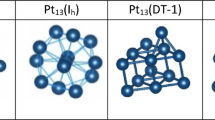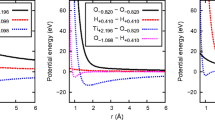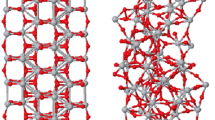Abstract
In the present paper, we examine the general applicability of different TiO2 model clusters to study of local chemical events on TiO2 sub-nanoparticles. Our previous DFT study of TiO2 activation through H adsorption and following deactivation by O2 adsorption using small amorphous Ti8O16 cluster were complemented by examination of rutile-type and spherical Ti15O30 nanoclusters. The obtained results were thoroughly compared with experimental data and results of related computational studies using other TiO2 models including periodic structures. It turned out that all considered model TiO2 model systems provide qualitatively similar results. It was shown that atomic hydrogen is adsorbed with negligible activation energy on surface O atoms, which is accompanied by the appearance of reduced Ti3+ species and corresponding localized band gap 3d-Ti states. Oxygen molecule is adsorbed on Ti3+ sites spontaneously forming molecular O2 – species by capturing an extra electron of Ti3+ ion, which results in disappearance of Ti3+ species and corresponding band gap states. Calculated g-tensor values of Ti3+ and O2 – species agree well with the results of EPR studies and do not depend on the used TiO2 model cluster. Additionally, it was shown that the various cluster calculations provide results comparable with the calculations of periodic structures with respect to the modeling of chemical processes under study. As a whole, the present study approves the validity of molecular cluster approach to study of local chemical events on TiO2 sub-nanoparticles.

Electronic structure diagrams for small Ti8O16H and large Ti15O30H hydrogenated clusters








Similar content being viewed by others
References
Chen X, Mao SS (2007) Titanium dioxide nanomaterials: synthesis, properties, modifications, and applications. Chem Rev 107:2891–2959. doi:10.1021/cr0500535
Banerjee A (2011) The design, fabrication, and photocatalytic utility of nanostructured semiconductors: focus on TiO2-based nanostructures. Nanotechnol Sci Appl 4:35–65. doi:10.2147/NSA.S9040
Reyes-Coronado D, Rodríguez-Gattorno G, Espinosa-Pesqueira ME et al (2008) Phase-pure TiO2 nanoparticles: anatase, brookite and rutile. Nanotechnol 19:145605. doi:10.1088/0957-4484/19/14/145605
Dittert B, Gavrilović A, Schwarz S et al (2011) Phase content controlled TiO2 nanoparticles using the MicroJetReactor technology. J Eur Ceram Soc 31:2475–2480. doi:10.1016/j.jeurceramsoc.2011.01.015
Oskam G, Hu Z, Penn RL et al (2002) Coarsening of metal oxide nanoparticles. Phys Rev E Stat Nonlinear Soft Matter Phys 66:011403. doi:10.1103/PhysRevE.66.011403
Oskam G, Nellore A, Penn RL, Searson PC (2003) The growth kinetics of TiO2 nanoparticles from titanium(IV) alkoxide at high water/titanium ratio. J Phys Chem B 107:1734–1738. doi:10.1021/jp021237f
Andreev AS, Kuznetsov VN, Chizhov YV (2012) Atomic hydrogen activated TiO2 nanocluster: DFT calculations. J Phys Chem C 116:18139–18145. doi:10.1021/jp3009805
Calatayud M, Maldonado L, Minot C (2008) Reactivity of (TiO2)n clusters (n=1−10): probing gas-phase acidity and basicity properties. J Phys Chem C 112:16087–16095. doi:10.1021/jp802851q
Calatayud M, Minot C (2009) Is there a nanosize for the activity of TiO2 compounds? J Phys Chem C 113:12186–12194. doi:10.1021/jp901465q
Lundqvist MJ, Nilsing M, Persson P, Lunell S (2006) DFT study of bare and dye-sensitized TiO2 clusters and nanocrystals. Int J Quantum Chem 106:3214–3234. doi:10.1002/qua.21088
Qu Z-W, Kroes G-J (2007) Theoretical study of stable, defect-free (TiO2)n nanoparticles with n = 10–16. J Phys Chem C 111:16808–16817. doi:10.1021/jp073988t
Qu Z-W, Kroes G-J (2006) Theoretical study of the electronic structure and stability of titanium dioxide clusters (TiO2)n with n = 1–9. J Phys Chem B 110:8998–9007. doi:10.1021/jp056607p
Syzgantseva OA, Gonzalez-Navarrete P, Calatayud M et al (2011) Theoretical Investigation of the Hydrogenation of (TiO2)n Clusters (n = 1–10). J Phys Chem C 115:15890–15899. doi:10.1021/jp2050349
Qu Z-W, Zhu H (2010) Do anionic titanium dioxide nano-clusters reach bulk band Gap? a density functional theory study. J Comput Chem 31:2038–2045. doi:10.1002/jcc
Yin X-L, Calatayud M, Qiu H et al (2008) Diffusion versus desorption: complex behavior of H atoms on an oxide surface. ChemPhysChem 9:253–256. doi:10.1002/cphc.200700612
Deskins NA, Rousseau R, Dupuis M (2010) Defining the role of excess electrons in the surface chemistry of TiO2. J Phys Chem C 114:5891–5897. doi:10.1021/jp101155t
Chrétien S, Metiu H (2008) Enhanced adsorption energy of Au1 and O2 on the stoichiometric TiO2(110) surface by coadsorption with other molecules. J Chem Phys 128:044714. doi:10.1063/1.2829405
Frisch MJ, Trucks GW, Schlegel HB et al. (2003) Gaussian 03, Revision B.05
Becke AD (1993) Density-functional thermochemistry. III. The role of exact exchange. J Chem Phys 98:5648
Vosko SH, Wilk L, Nusair M (1980) Accurate spin-dependent electron liquid correlation energies for local spin density calculations: a critical analysis. Can J Phys 58:1200–1211. doi:10.1139/p80-159
Perdew JP, Chevary JA, Vosko SH et al (1992) Atoms, molecules, solids, and surfaces: Applications of the generalized gradient approximation for exchange and correlation. Phys Rev B: Condens Matter Mater Phys 46:6671–6687. doi:10.1103/PhysRevB.46.6671
Burke K, Perdew JP, Wang Y (1998) Derivation of a generalized gradient approximation: the PW91 density functional. In: Dobson JF, Vignale G, Das MP (eds) Electron. Density Funct. Theory: Recent Prog. New Dir. Plenum Press, New York, pp 81–111
Perdew JP (1991) Unified theory of exchange and correlation beyond the local density approximation. In: Ziesche P, Eschrig H (eds) Electronic structure of solids. Akademie Verlag, Berlin, pp 11–20
Perdew JP, Chevary JA, Vosko SH et al (1993) Erratum: atoms, molecules, solids, and surfaces: applications of the generalized gradient approximation for exchange and correlation. Phys Rev B: Condens Matter Mater Phys 48:4978. doi:10.1103/PhysRevB.48.4978.2
Perdew JP, Burke K, Wang Y (1996) Generalized gradient approximation for the exchange-correlation hole of a many-electron system. Phys Rev B: Condens Matter Mater Phys 54:16533–16539. doi:10.1103/PhysRevB.54.16533
Xiao H, Tahir-Kheli J, Goddard WAI (2011) Accurate band gaps for semiconductors from density functional theory. J Phys Chem Lett 2:212–217. doi:10.1021/jz101565j
Kaupp M, Reviakine R, Malkina OL et al (2002) Calculation of electronic g-tensors for transition metal complexes using hybrid density functionals and atomic meanfield spin-orbit operators. J Comput Chem 23:794–803. doi:10.1002/jcc.10049
Hay JP, Wadt WR (1985) Ab initio effective core potentials for molecular calculations. Potentials for K to Au including the outermost core orbitals. J Chem Phys 82:299
Hehre WJ, Ditchfield R, Pople JA (1972) Self—consistent molecular orbital methods. XII. Further extensions of Gaussian—type basis sets for use in molecular orbital studies of organic molecules. J Chem Phys 56:2257
Hariharan PC, Pople JA (1973) The influence of polarization functions on molecular orbital hydrogenation energies. Theor Chim Acta 28:213
Clark T, Chandrasekhar J, Spitznagel GW, Schleyer PVR (1983) Efficient diffuse function-augmented basis sets for anion calculations. III. The 3-21+G basis set for first-row elements, Li-F. J Comput Chem 4:294–301. doi:10.1002/jcc.540040303
NIST (2011) Computational Chemistry Comparison and Benchmark Database. Release 15b. http://cccbdb.nist.gov/
Berger T, Diwald O, Knözinger E et al (2007) Hydrogen activation at TiO2 anatase nanocrystals. Chem Phys 339:138–145. doi:10.1016/j.chemphys.2007.06.021
Deskins NA, Rousseau R, Dupuis M (2009) Localized electronic states from surface hydroxyls and polarons in TiO2 (110). J Phys Chem C 113:14583–14586. doi:10.1021/jp9037655
Deskins NA, Rousseau R, Dupuis M (2011) Distribution of Ti3+ surface sites in reduced TiO2. J Phys Chem C 115:7562–7572. doi:10.1021/jp2001139
Morgan BJ, Watson GW (2007) A DFT+U description of oxygen vacancies at the TiO2 rutile (110) surface. Surf Sci 601:5034–5041. doi:10.1016/j.susc.2007.08.025
Morgan BJ, Watson GW (2010) Intrinsic n-type defect formation in TiO2: a comparison of rutile and anatase from GGA+ U calculations. J Phys Chem C 114:2321–2328. doi:10.1021/jp9088047
Helali Z, Markovits A, Minot C, Abderrabba M (2012) First-row transition metal atoms adsorption on rutile TiO2(110) surface. Struct Chem 23:1309–1321. doi:10.1007/s11224-012-0058-3
Deskins NA, Dupuis M (2007) Electron transport via polaron hopping in bulk TiO2: a density functional theory characterization. Phys Rev B 75:195212. doi:10.1103/PhysRevB.75.195212
Berger T, Sterrer M, Diwald O, Knözinger E (2005) Charge trapping and photoadsorption of O2 on dehydroxylated TiO2 nanocrystals-an electron paramagnetic resonance study. ChemPhysChem 6:2104–2112. doi:10.1002/cphc.200500161
Komaguchi K, Maruoka T, Nakano H et al (2010) Electron-Transfer Reaction of Oxygen Species on TiO2 Nanoparticles Induced by Sub-band-gap Illumination. J Phys Chem C 114:1240–1245. doi:10.1021/jp909678e
Leconte J, Markovits A, Skalli MK et al (2002) Periodic ab initio study of the hydrogenated rutile TiO2(110) surface. Surf Sci 497:194–204. doi:10.1016/S0039-6028(01)01477-7
Di Valentin C, Pacchioni G, Selloni A (2006) Electronic structure of defect states in hydroxylated and reduced rutile TiO2(110) surfaces. Phys Rev Lett 97:166803. doi:10.1103/PhysRevLett.97.166803
Finazzi E, Di Valentin C, Pacchioni G, Selloni A (2008) Excess electron states in reduced bulk anatase TiO2: comparison of standard GGA, GGA+U, and hybrid DFT calculations. J Chem Phys 129:154113. doi:10.1063/1.2996362
Di Valentin C, Pacchioni G, Selloni A (2009) Reduced and n-Type Doped TiO2: Nature of Ti3+ Species. J Phys Chem C 113:20543–20552. doi:10.1021/jp9061797
Kuznetsov VN, Serpone N (2009) On the origin of the spectral bands in the visible absorption spectra of visible-light-active TiO2 specimens analysis and assignments. J Phys Chem C 113:15110–15123. doi:10.1021/jp901034t
Khomenko VM, Langer K, Rager H, Fett A (1998) Electronic absorption by Ti3+ ions and electron delocalization in synthetic blue rutile. Phys Chem Miner 25:338–346. doi:10.1007/s002690050124
Sekiya T, Yagisawa T, Kamiya N et al (2004) Defects in anatase TiO2 single crystal controlled by heat treatments. J Phys Soc Jpn 73:703–710. doi:10.1143/JPSJ.73.703
Henderson MA (2011) A surface science perspective on TiO2 photocatalysis. Surf Sci Rep 66:185–297. doi:10.1016/j.surfrep.2011.01.001
Kuznetsov VN, Krutitskaya TK (1996) Nature of color centers in reduced titanium dioxide. Kinet Catal 37:446
Henderson MA, Epling WS, Perkins CL et al (1999) Interaction of molecular oxygen with the vacuum-annealed TiO2 (110) surface: molecular and dissociative channels. J Phys Chem B 103:5328–5337. doi:10.1021/jp990655q
Kuznetsov VN (2002) Study of oxygen adsorption and reoxidation of reduced titanium dioxide by thermal desorption mass spectrometry. Kinet Catal 43:868–873
Haerudin H, Bertel S, Kramer R (1998) Surface stoichiometry of “titanium suboxide”, part I volumetric and FTIR study. J Chem Soc Faraday Trans 94:1481–1487. doi:10.1039/a707714i
Acknowledgments
The authors thank Prof. Alexei Emeline and Prof. Vladimir Ryabchuk for fruitful discussions. The present work was supported by Russian Foundation of Basic Research (Grant 10-03-00638-а) and St. Petersburg State University (Grant 11.37.25.2011). Computational resources were provided by Service of Informational Technologies of St. Petersburg State University (St. Petersburg, Russia).
Author information
Authors and Affiliations
Corresponding author
Electronic supplementary material
Below is the link to the electronic supplementary material.
ESM 1
(PDF 9235 kb)
Rights and permissions
About this article
Cite this article
Andreev, A.S., Kuznetsov, V.N. & Chizhov, Y.V. DFT model cluster studies of O2 adsorption on hydrogenated titania sub-nanoparticles. J Mol Model 19, 5063–5073 (2013). https://doi.org/10.1007/s00894-013-2000-z
Received:
Accepted:
Published:
Issue Date:
DOI: https://doi.org/10.1007/s00894-013-2000-z




